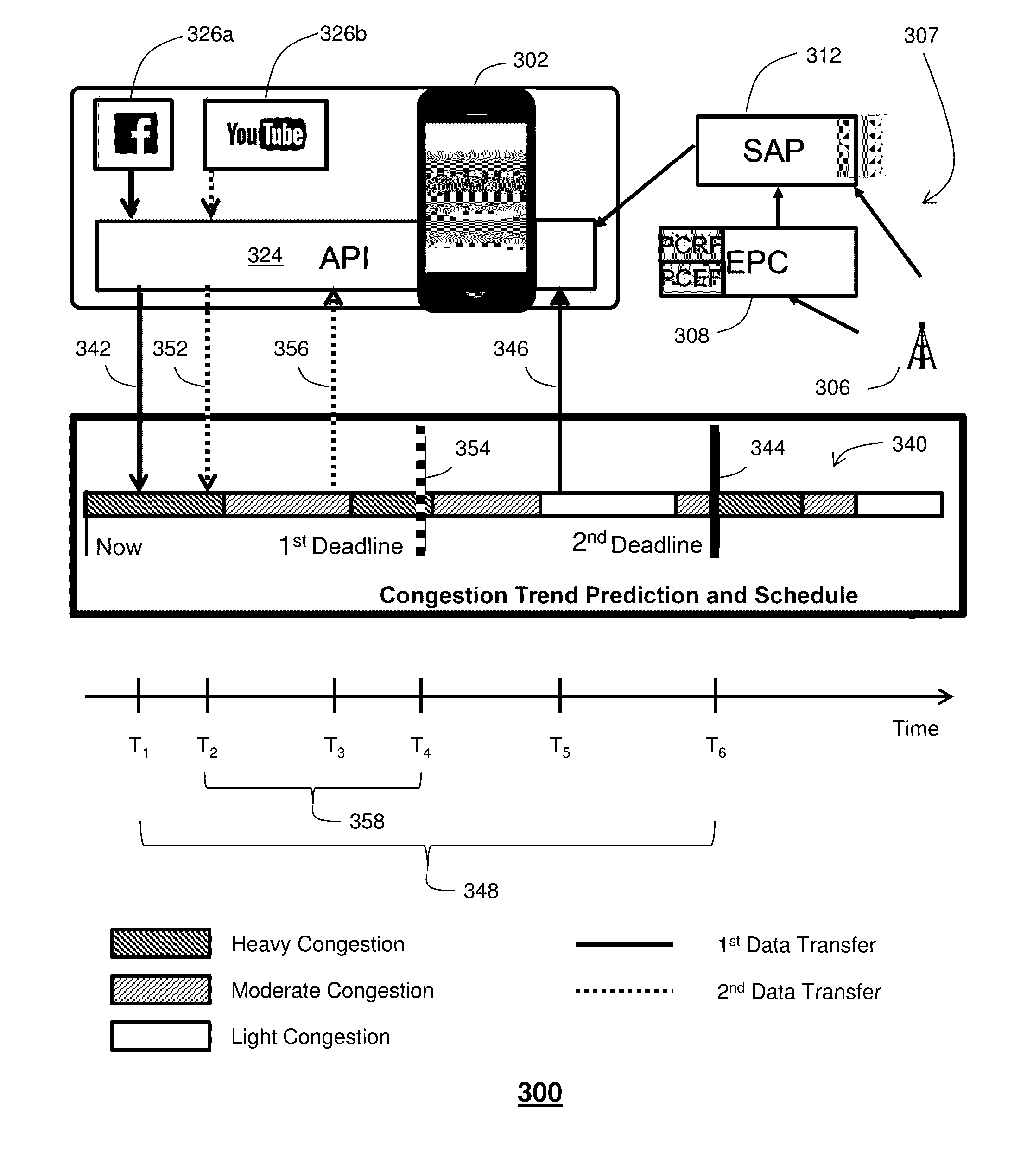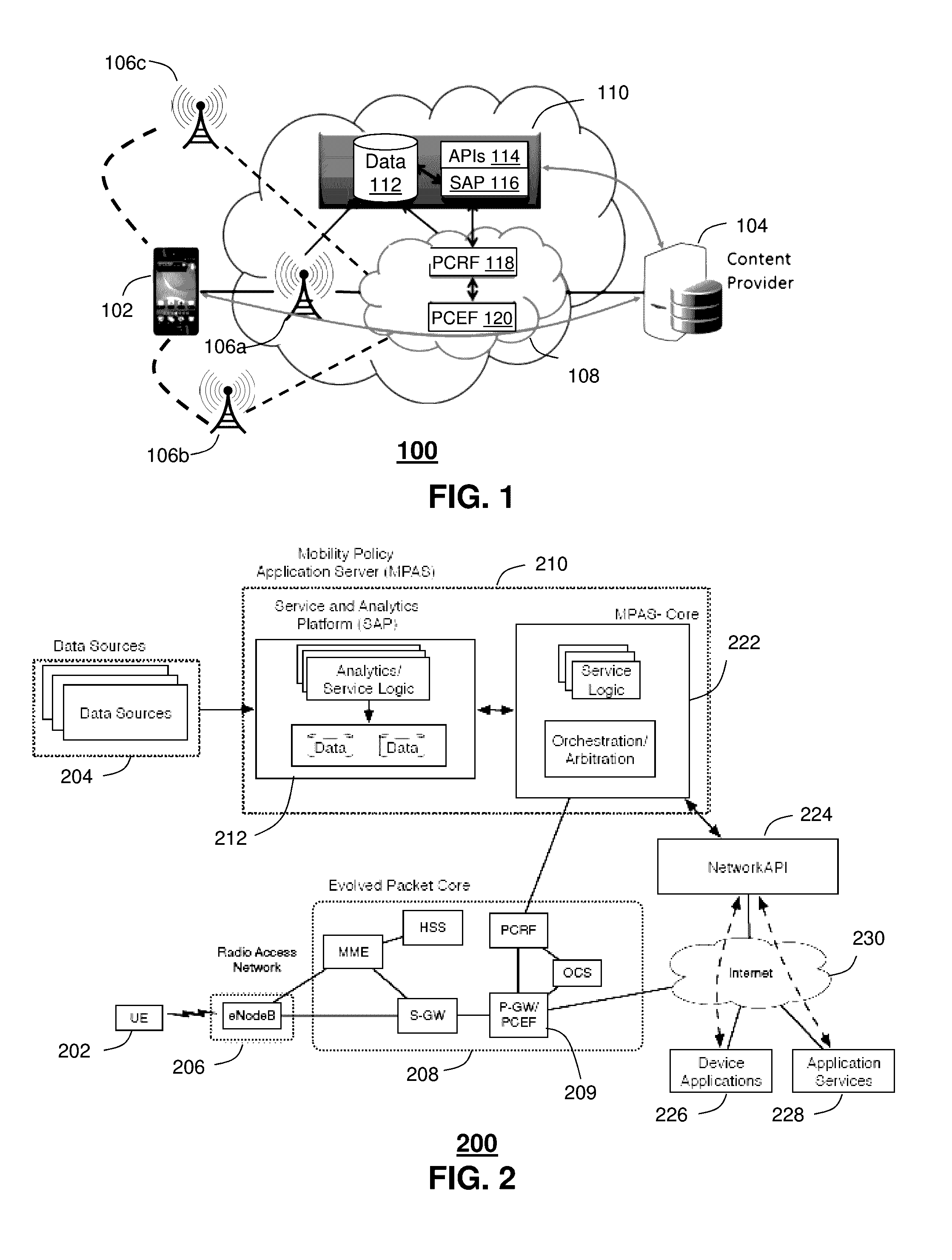There may be occasions when the utilization forecast is not accurate.
Since mobile cellular networks are designed to meet some maximum demand, it is conceivable that heavy congestion could result in an undesirable overload condition.
Overloads may result in dropped calls or data requests, delays, application of data throttling and the like.
It is also understood that due to certain unpredictability in any actual utilization, there may be instances in which a predicted time-shifted transfer time will occur during an unexpected period of heavy utilization or congestion.
Alternatively, there may be instances between a request time and any scheduled time-shifted transfer time during which utilization or congestion is low, presenting an unanticipated opportunity for completing the transfer.
It is also conceivable that the
mobile device will move to unanticipated locations posing new opportunities for download, and / or presenting challenges for pre-scheduled time-shifted downloads.
There are a number of fundamental challenges in time-shifting data to / from mobile devices.
Even if a substantial amount of data can be scheduled in advance, there will always be a large and changing amount of time-sensitive traffic which is not known in advance.
Users are not stationary, potentially moving in an unpredictable manner to different base stations on the scale of regions, e.g., cities.
Downloading as much data as can safely be downloaded now, e.g., within a current scheduling window, without adding a new utilization spike, ensures that the data will not need to be downloaded later when adding a utilization spike may become unavoidable.
The approach may offer limited improvements under certain conditions, e.g., when data loads are already very evenly spread with low peak-to-valley ratios, or congestion too high to offer time-shifting opportunities.
Scheduling content effectively is challenging.
This level of error means data in the network not scheduled or otherwise unknown can be unpredictable.
Furthermore, other devices on the network also schedule traffic, presenting a risk that scheduling data at the same time as other devices, creating a new utilization spike.
Furthermore, when deadlines are on the order of hours, these decisions only need to be made every few minutes.
Keeping the load below this threshold is essential to reducing maximum utilization, but under-scheduling data in a present time slot may result in the threshold being exceeded in a later time slot.
However, if the previous threshold was exceeded due to underestimating the load, the target threshold is not increased.
Otherwise, such increases would push the threshold higher at each failure to correctly predict the network utilization.
Although data loading might be consistently lower during some period of a day, such as during the
evening or overnight, it may not be desirable in at least some instances to tailor the threshold to reflect such historical trends.
In an illustrative example, the period is set to one day, and the
algorithm is slightly modified by eliminating a
linear trend term, which leads to an over-fitting.
However, predicting which
eNodeB a user will connect to in the future is challenging.
However, simply shifting all network traffic to occur at night is insufficient.
There are likely cases where applications or users have some constraints on when data should be downloaded.
For instance, when prefetching, data must have been generated before it can be pre-fetched, and when delaying data, users may be unwilling to wait until the middle of the night to consume content.
By only making use of free capacity at night, available capacity during the
daytime is wasted.
That is scheduling is slightly under a target threshold to account for occasional errors in forecasting network load, which are unavoidable in any prediction
algorithm.
However, users delaying content might be unwilling to wait to consume the content until a time when they would normally be asleep; conversely, content that is pre-fetched automatically by the application (such as the daily news) may not have been generated during the middle of the night.
This approach is impractical due to the data and battery overhead of constantly sending network load updates all day, even when the device is not actively scheduling data.
The overhead of INS computation was not an issue at all due to
algorithm design, but the battery overhead of
server-
client coordination needs to be considered.
Since only a small amount of data is sent, the RRC
tail timers have a large
impact on
power consumption, and so if there is other traffic on the device, the actual added
power consumption due to time-shifting would be far lower.
Nevertheless, this overhead motivates the need for time-shifting to support intermittent, rather than continuous,
server synchronization.
These are limitations of the
simulation, not of the time-shift approach as a whole.
Since the data on
eNodeB loads consists of PRB utilization data and not network traces, information about the
data type that is being requested is not available to support a determination as to what fraction of the data is time-shiftable.
Having devices pick times to download at random was also examined, but for large downloads, even a small number of users randomly selecting the same time could lead to new congestion peaks.
It was found that these peaks occurred often enough to negate any benefits of time-shifting.
By primarily evaluating the worst-case load, random selection are not suitable, unlike in scheduling approaches that care primarily about average results.
This would be impractical for many use cases, however.
First, a very large data load was examined.
There are some limitations with this dataset, particularly mapping users in the
eNodeB load trace to the video load, and dealing with the fact that the control case has a high amount of load during off-peak hours.
In particular, users who experience very poor
signal strength during off-peak hours would saturate the connection during this time, and so could not
stream the video in the case without time-shifting, making a fair comparison hard.
Comparable results were achieved as with other loads, although the
impact on lightly-loaded eNodeBs was reduced less effectively.
A case corresponding to users streaming music during their daily commute was examined, leading to a large amount of traffic during a few hours of the day only.
With a much shorter two hour deadline, however, no benefits were observed from time-shifting.
When data is already evenly spread out, it is harder to spread it further when the time constraints are insufficiently flexible.
Per-eNodeB forecasts are can be used to estimate the average utilization in the next time slot, but these forecasts, even 15 minutes in advance, are generally not perfect.
This shows that results are limited by imperfect predictions, not by a particular short-term scheduling algorithm.
In the congested case, time-shifting effectively is more challenging, and the
impact of time-shift-controlled traffic was only reduced by about 35% on average.
It can help us use network resources more efficiently, but may not add more total network capacity.
Ubiquitous WiFi is one such approach, but has been shown to have limitations in offering truly ubiquitous coverage, and in fact the trend has been towards more
mobile broadband usage.
In some embodiments
traffic shaping can be applied to reduce peak congestion, at the cost of some loss in performance.
Still other approaches can include prefetching data when it could potentially lead to excessive data usage.
For example, heavy data users tend to be clustered in a few hotspots in large cities, causing
network congestion.
 Login to View More
Login to View More  Login to View More
Login to View More 


